Volta Redonda to Aracaju Road Trip, December, 2014
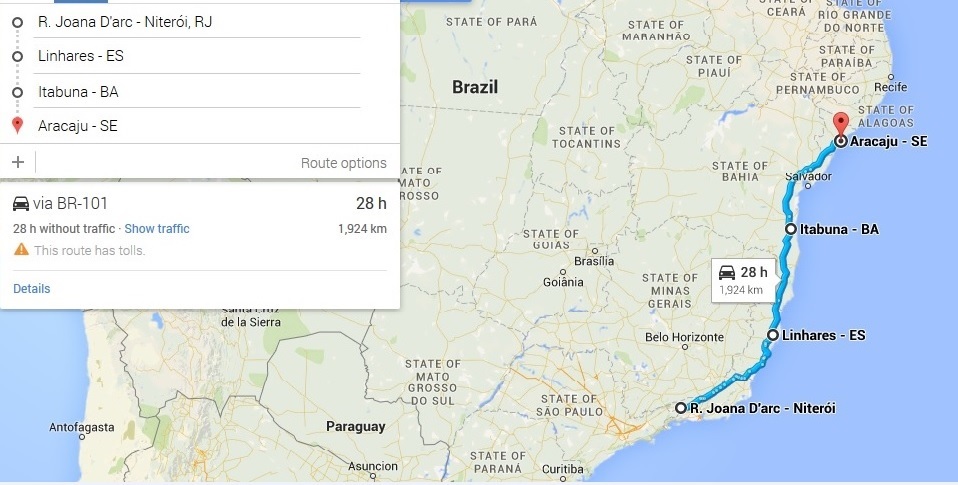
After spending Christmas, 2014 at our home in Volta Redonda, state of Rio de Janeiro, we were planning on visiting Monica’s Aunt Laiz in Aracaju, in the State of Sergipe, in the northeast of Brazil. It’s only 2000km, or about 1200 miles, so we decided to do it by car.
Make no mistake, this was likely the most expensive way to make the trip. I just checked Kayak, and round trip nonstop tickets for two from Rio to Aracaju are about $650. We spent about $400 in gasoline (avg.about $5/US per gallon) plus 8 nights in hotels, meals, etc. However, I thought it would be an adventure and give us a unique chance to view a good part of the country.
Trip Planning
Since we wanted to be in Aracaju for New Years, and we were going to leave on the 27th, we didn’t have a lot of time. We decided to drive 8-10 hrs/day and get there in three days. Google maps said that it could be done and our GPS concurred. We decided to stop for the first night in Linhares, at the Days Inn and the second night in Itabuna, at the Hotel Beira Rio. Since it is prime vacation time in Brazil, we made reservations in advance, pretty much locking us into the three day schedule. I thought that sticking to BR-101, which follows the coast, would allow us to see lots of neat stuff, so we planned on going that way.
So, off we go!
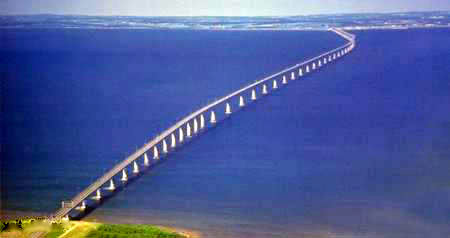
We had everything packed and ready to go early in the morning. The day before we left, I caught a nasty cold and had a fever, so all of those last-minute details that usually get done just before you leave didn’t happen with the normal level of detail. Regardless, we got in our little car and headed out on Saturday morning, guided by our GPS.
The GPS has some sort of algorithm that computes the best route by distance, traffic, the position of the moon, whatever. It decided that the best way to BR-101 was directly through the city of Rio de Janeiro, across the big bridge into Niteroi, and up the coast.
The GPS, however didn’t consider that it’s prime vacation time, it’s Saturday morning, and everyone in Rio was going to use the same road to go to the beach towns north of the city. We lost a couple of hours to the crawling traffic, but soon were on our way north. The bright side was that we got to go through Rio and across the bridge to Niteroi,, one of Rio’s landmarks.
BR-101 (hint: it isn’t anything like PCH)
BR-101 was the main road that we followed. It is nothing like a US interstate – it only has two lanes in most places. It is also used by trucks. Big, slow, underpowered trucks that have a lot of trouble going up hills. This part of BR-101 is almost all hills. You are going up, going down or going around mountains almost every minute that you are on the highway. So are the trucks. Even though our Fiesta only has a 997cc engine with 70hp, we still had to pass trucks. In our underpowered little car, it was an adventure.

Passing trucks in a 1.0 liter Fiesta requires a lot of planning, nerves of steel and the ability to ignore the screaming Brasileira in the passenger seat who believes that every passing maneuver is an attempt to introduce her to her ancestors. For the most part, the center line was marked well with the appropriate broken lines where passing was allowed and solid lines where passing involved a death wish. I tried to honor the line markings, but I think that I was the only driver that did. Often, I would start to pull out to pass and find someone coming up behind me, attempting to pass not only the slow truck, but the line of cars behind it, forcing me back into my spot behind the truck, waiting for the next time.
The condition of the road varied. During the southern part of the trip, the road was pretty nice – likely because they were toll roads. There was some new asphalt, newly painted lines and smooth surfaces. There were also extra passing lanes on some of the hills, put there to allow cars to pass the slower-moving trucks without endangering their lives. In theory, this works great. In practice, much of the time the passing lane was occupied by a slow-moving truck passing a slower-moving truck while both of them were belching full-throttle clouds of diesel smoke that enveloped the cars that remained lined up behind them who likely wouldn’t get a chance to pass either of the trucks.
Once we got into the state of Bahia, farther north, the tolls stopped but the road became worse. Guard rails disappeared, the road had a lot of patches and passing lanes on hills became hard to find. We didn’t have to pay tolls anymore, however. During the trip, I noticed that many of the slower-moving trucks that we had just passed blew right past us again while we were waiting in line to hand over our $2 (more or less) to the toll takers. The trucks had the Brazilian version of EZ-Pass, so…… every time we had to stop and pay a toll, four or five trucks that we just had passed had to be passed again. 20km from Aracaju, BR-101 became a four-lane highway. Wow, what a difference….
First Stop: Days Inn Linhares
Thanks to the traffic delays and my crappy cold, I was completely beat when we pulled into the hotel in Linhares for the first night. OK, it was thirteen hours instead of ten, and it was approaching 9pm. We could not have chosen a better place to stop. The hotel was clean – spotless, actually. It was a modern hotel with a restaurant at street level with glass walls. My only complaint was the key card system. For security, you need to swipe your RFID-equipped key card to open your door, even to get the elevator to work – unfortunately, you also need to have the key card nestled in a pocket near the door in order to have any electricity in your room. No lights, no A/C, no TV unless your card (meaning YOU) is in the room. Great idea, unless you left something in the car, parked in the underground garage. You need to take the key with you to ensure that you can take the elevator back to the room, but your exhausted wife is only going to have 5 minutes until the room is plunged into total darkness. I left her a flashlight. Come on, hotel people, I can understand not having the A/C running, but could we spare a couple of more minutes? Or maybe one little curly CFL light fixture in the room that isn’t going to go out? Would that cost so much?
As we weren’t in any mood to go restaurant hunting, the hotel offered us a buffet dinner that we shared with a wedding party. It was great, and allowed us to get to our darkened room early for bed. We left on time the next morning, fortified by an excellent buffet breakfast (included in the room price.) Oh, and my fever had passed during the night. Yay!
Day 2: Pass the Truck, rinse, repeat….
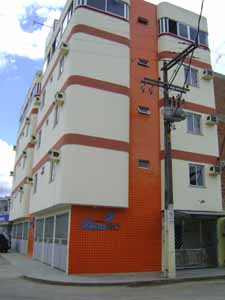
No changes in Sunday’s drive from Saturday, except that we passed into the state of Bahia, where the road got a little worse but the tolls stopped. We drove BR-101 all day, arriving in Itabuna as it was getting dark. We spent night #2 at Hotel Beira Rio, basically because it was one of two hotels listed on Trip Advisor in Itabuna, and it had the better reviews. Hotel Beira Rio is next to a river “Beira Rio” and it is a little away from the center of town. Unlike the gringo hotel that we had the night before, Beira Rio was a typically Brazilian hotel. It was a bit older and the room was a little smaller. However, it used the very same stupid electricity trick as Days Inn did. Your conventional hotel key was on a ring with a card that had to be stuck in a pocket on the wall or you didn’t get electricity. On the way home, we stayed mostly at small pousadas, so we didn’t have that problem again.
We had more time Sunday night (no Rio de Janeiro beach traffic), so we walked over a few blocks to an open-air-type restaurant. We dined on cold beer and warm meat while the Globo novellas played on the TV above our heads. Itabuna really didn’t impress us as a city that we would want to spend much time in – it was just a place to stop on the way to get somewhere else.
Day 3: Into Aracaju
Pass the trucks, pass the trucks, etc. Monday’s drive was nothing new, except that the last 20km or so of BR-101 opened up into a four-lane road as we approached Aracaju. Boy, did that make a difference! Anyway, we were able to make it to our destination as scheduled. and we enjoyed a very nice visit with some very nice people.
BR-101 Recap:
A couple of things that I noticed: Gasoline was about 10% less in Bahia than it was in Volta Redonda. I’m not sure why – maybe because there’s more money in the south. We buy a little over 40 liters at a time, and my credit card web site says that we spent $50US per fill up, so we’re looking at about $5/gallon avg fuel price. I read in today’s paper that the government is increasing the gasoline tax by about 25 cents per liter starting Feb 1. Could you imagine the US government making such an announcement?
We shared the roads with some of the most undisciplined drivers that I have ever seen. Cars, even trucks, treated lane markings as mere suggestions. We once had a big truck ahead of us swing wide through a curve AS I WAS PASSING IT IN THE PASSING LANE, causing me to brake hard, lose my hard-won momentum and my chance to pass as well (but I’m alive!). We saw lots of aggressive drivers who thought nothing of ignoring the rules of the road in order to gain a two-second advantage. There is little traffic enforcement on BR-101. Traffic is controlled with speed bumps and speed cameras, which mail expensive tickets right to your door. I got pretty good at spotting the speed cameras – or at least I hope that I did. The official speed limit through the two-lane portions of BR-101 is 80 km/h or just less than 50 mph. Right.

A word about fuel stations. Three letters, actually – yuk. Why can’t they have clean bathrooms? Monica had to carry her own TP, and once she ran out, bought her own roll at the same gas station that didn’t have any in their bathrooms. As a guy, I don’t get all that personally involved with gas station bathrooms, but I felt bad for Monica. Also, one Petrobras station didn’t have gasoline – I suppose that’s not such a big deal – I could easily have put ethanol in our flex-fuel Fiesta. Another couple of them accepted debit cards but not credit cards – others charged significantly higher prices for using a credit card. In short, it was a surprise every time we stopped for fuel. Hey, I just want to stop, pee, get a tank of gas without any surprises and get down the road – these guys need to work on that.
In short, the drive itself was the exact opposite experience of a trip down say, I-95, where you park in the right lane, turn on the cruise control and wait until you need gasoline. It was exhausting and a drain on the spirit. Not fun at all.
We chose the BR-101 route because it paralleled the coast, and I have some experience on the southern part that connects Rio and Sao Paulo. On this part of BR-101, it’s different. Except for a few short glimpses, we didn’t see any sea at all. In fact, most of the time, we were 30km or more from the ocean. I saw hills, curves and trucks with little variation through the trip. There wasn’t anything particularly beautiful or exceptional about this particular highway – I guess I was wrong to expect that. We did see lots of green, thousands of cows and a few hundred speed bumps, though……
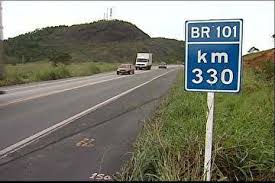

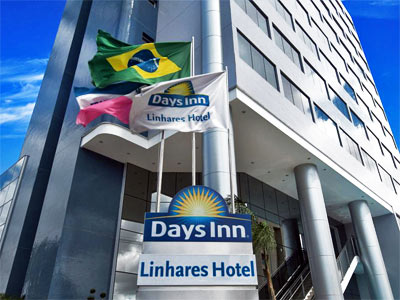
Leave a Reply